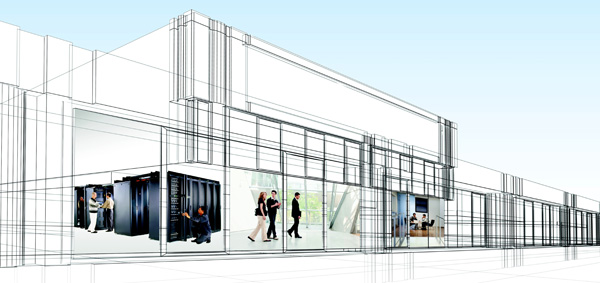Distribute power to Data Center
One-way electricity distribution has recently been proposed as the Alternating Power Alternative method for Data Centers (TTDs), however the information flows and conflicting announcements have caused fierce debate in the industry. . By detailed analysis based on specific operational models, Neil Rasmussen, InfraStruXure system chief engineer, APC Senior Vice President, Schneider Electric Group has proved that many benefits are attributed to the source. One-way electricity distribution is not accurate, thus explaining the cause of AC electricity will still be the first choice for data centers.
Power distributed to IT equipment in data centers or network-level rooms can be combined with either One-way or One-way use. AC power is usually supplied at 120V, 208V or 230V. Unidirectional power is usually provided for standard telecommunication equipment at 48V. Most devices use AC power, however, since the 1990s many manufacturers and engineers have shown the advantages and predictions of DC electricity will be widely used for standard data centers, But the rotating electric reality has not been throne.
Recently, on a number of technology forums, a new concept has been proposed, one-way power distribution with voltage potential at 300V, 380V, 400V and 575V, to overcome the disadvantages of 48V DC . From calculating the performance of 2 AC models and 3 models of electricity distribution One-way discussion is 480V to 208V AC, 400 / 230V AC, 48V One-way, 380V One-way, and 575V One-way hybrid. Neil Rasmussen and his team showed typical features, advantages and limitations of AC and DC on specific elements such as Cost, Compatibility, Reliability, Harmonics and Weaknesses. safety factor.

One-way electricity can help reduce costs but is less compatible
In terms of material costs and equipment, AC power has a small advantage over the 48V DC method when applied to data centers or network power rooms. Because currently only a small number of devices are compatible with the 380V DC system, the AC system still has no advantage in price. However, if it becomes a widely applied standard, the DC DC 380V system has the potential for cost compared to the AC systems currently in use.
In terms of compatibility, switching telecommunications equipment such as audio transmission using copper rings have long been designed for DC DC 48V power sources. Telecommunications devices that transfer packages such as servers, storage devices, routers . are always designed to use AC power. The function of the device will therefore determine whether AC or DC power will be more compatible. The overwhelming number of devices operating in packages in network rooms or data centers offers the advantage of compatibility for AC power.
As a result of comparative studies, it is clear that the assurance of the whole system is determined by the battery system. With a cost equivalent to a life cycle, it is difficult to calculate the specificity of the stability of DC or AC systems for data centers or network rooms.
Unidirectional electricity does not help eliminate harmonics and unsafe
Many publications claim that the key benefit when switching to DC electricity is the type of elimination of harmonics. However, it should be noted that since 1993 international regulations have banned the production of IT equipment that generate harmonics. Only data centers that use production equipment before 1993 have encountered this problem, so announcing the One-way Power Distribution method helps eliminate harmonics is completely wrong and obsolete.
Regarding safety, there are many important contents related to the regulation of AC electricity distribution applied globally, based on the history of nearly 100 years of commercial electricity distribution and living. In contrast, there are only a few regulations related to One-way electricity distribution for trade, which is a major obstacle to the ability to quickly apply One-way electricity. For example, designs for DC 380V electricity will violate the laws in Japan, because the limit in this country is 300V. Electrical installation One-way larger than 48V electricity One-way in a modern data center will pose challenges to consulting firms - designers, contractors, and local authorities.
Network and Data Center will still be completely different devices combined together, and with many devices, AC power is always the most practical option. Unidirectional electricity is still an option for the system for microchip-based networks, such as traditional wired telephone networks. However, the flexibility and compatibility along with the reality of outstanding performance of AC power options confirms the irreplaceable position for network and data centers.
(According to APC by Schneider Electric study 63)
You should read it
- 7 steps for a green data center
- The impressive images of the data center are located at a depth of 35m on the seabed of Microsoft
- Microsoft CEO Satya Nadella will bring the data center to the sea
- For the first time, Vietnam has a data center of international standard
- Where does Google store your YouTube and Gmail videos?
- 2 ways to help data center save electricity
 File transfer between iPad and Mac
File transfer between iPad and Mac 10 things to help maintain Internet bandwidth
10 things to help maintain Internet bandwidth 7 ways to work faster in Windows 7
7 ways to work faster in Windows 7 Google Wallet: 5 things to know
Google Wallet: 5 things to know 5 tips to free up hard drive space
5 tips to free up hard drive space Solve the top 10 most annoying problems on the web
Solve the top 10 most annoying problems on the web